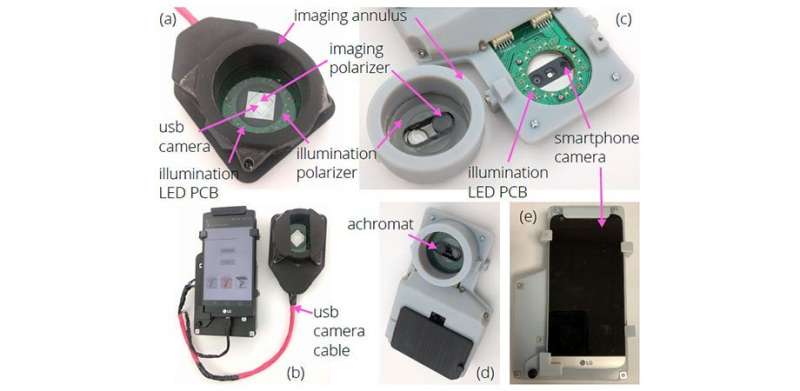Two dermascope implementations. The USB-camera-based PMSI and PWLI dermascope is shown in (a) and (b). (a) Various components of the handheld imaging module (the USB camera is hidden behind the imaging polarizer) and (b) the imaging module paired with the smartphone camera. The smartphone-camera-based PMSI and PWLI dermascope is shown in (c), (d), and (e). (c) The smartphone-based system’s side opposite the smartphone screen with the imaging annulus removed, where the LED PCB and smartphone camera are visible and other components are highlighted; (d) the system with the imaging annulus attached; and (e) the smartphone installed in the dermascope. Credit: SPIE
An article published in the Journal of Biomedical Optics (JBO), "Point-of-care, multispectral, smartphone-based dermascopes for dermal lesion screening and erythema monitoring," shows that standard smartphone technology can be adapted to image skin lesions, providing a low-cost, accessible medical diagnostic tool for skin cancer.
Skin lesions are diagnosed by a simple system of color, size, asymmetry, and surface appearance: the way in which the lesions are lit indicates differences between normal and malignant lesions. For their study, the authors developed two dermascopes using a smartphone-based camera and a USB-based camera. Both dermascopes, integrating LED-based polarized white-light imaging (PWLI), polarized multispectral imaging (PMSI) and image-processing algorithms, successfully mapped and delineated between the dermal chromophores indicative of melanoma, and the general skin redness known as erythema.
According to JBO Editor-in-Chief, SPIE Fellow, and MacLean Professor of Engineering at Dartmouth Brian W. Pogue, leveraging a smartphone camera to image skin lesions improves both the efficiency and efficacy of skin-lesion diagnostics."The functionality and performance for the detection of skin cancers is very important," he said. "The cellphone camera approaches proposed and tested in this paper introduce key steps in a design that will provide simple, accurate diagnoses. While there are always ways to make medical imaging systems work, they can often be too expensive to be a viable commercial success. Similarly, devices can be made so complex that they aren't readily adopted. Here, the already-familiar platform is both low cost and intuitive to use. The simplicity of the approach here successfully combines the need for simple diagnostic tools with high precision. This is the kind of innovation that will potentially allow for easier adoption in clinical use."
More information: Ross D. Uthoff et al, Point-of-care, multispectral, smartphone-based dermascopes for dermal lesion screening and erythema monitoring, Journal of Biomedical Optics (2020). DOI: 10.1117/1.JBO.25.6.066004
Journal information: Journal of Biomedical Optics
Provided by SPIE
























